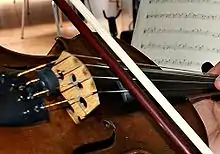Tack piano
A tack piano (also known as a harpsipiano, jangle piano, and junk piano) is an altered version of an ordinary piano, in which objects such as thumbtacks or nails are placed on the felt-padded hammers of the instrument at the point where the hammers hit the strings, giving the instrument a tinny, more percussive sound. It is used to evoke the feeling of a honky-tonk piano.[1]

Tack pianos are commonly associated with ragtime pieces, often appearing in Hollywood Western saloon scenes featuring old upright pianos.[2] The instrument was originally used for classical music performances as a substitute for a harpsichord.[3]
Honky-tonk piano
The timbre of decrepit pianos can approximate a tack piano due to hardened or worn away hammer felt. Another important characteristic of the Honky-tonk piano is the detuning of one or more strings of each key, producing acoustic beats in a manner similar to undulating organ stops.[1] In Wozzeck (1925) Alban Berg calls for such a "Pianino" in the bar scene.[4]
See also
References
- Everett, Walter (2009). The Foundation of Rock: From "Blue Suede Shoes" to "Suite: Judy Blue Eyes". Oxford University Press. p. 70. ISBN 978-0-19-531023-8.
- Malvinni, David (2016). Experiencing the Rolling Stones: A Listener's Companion. Rowman & Littlefield. p. 89. ISBN 978-0-8108-8920-0.
- Miller, Leta (1998). "Incidental Music for Corneille's Cinna (Suite for Tack Piano)". In Harrison Lou (ed.). Selected Keyboard and Chamber Music: 1937–1994. A-R Editions. p. 41. ISBN 978-0-89579-414-7.
- Wozzeck (Berg): Scores at the International Music Score Library Project
